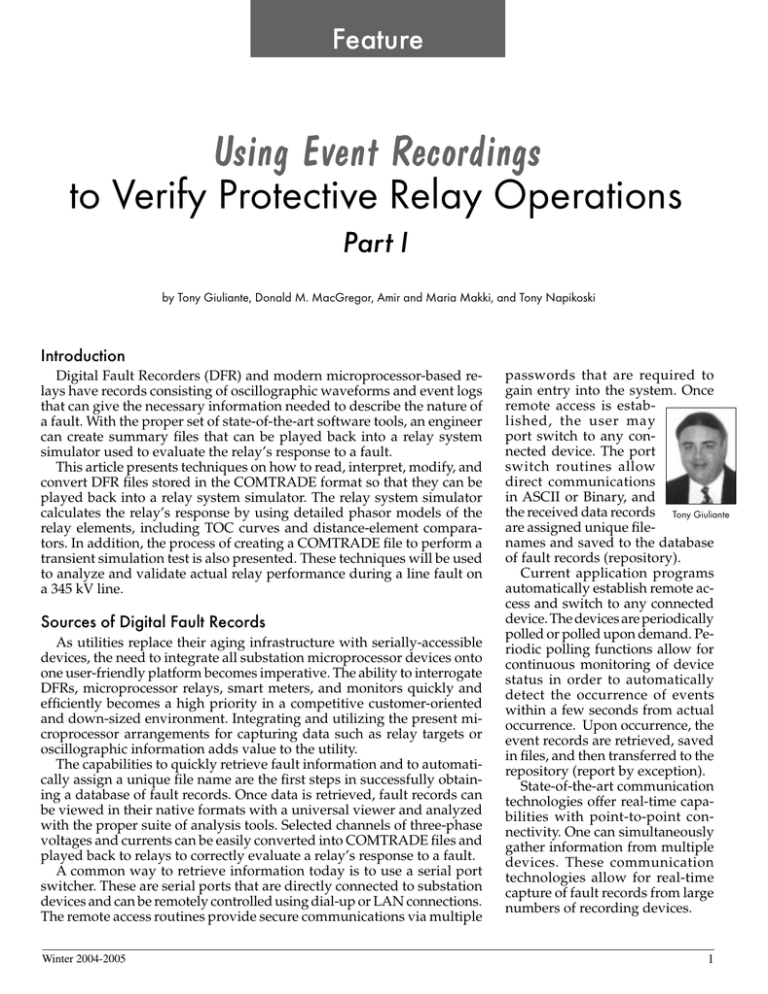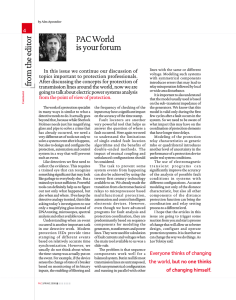Using Event Recordings to Verify Protective Relay Operations
advertisement

Feature Using Event Recordings to Verify Protective Relay Operations Part I by Tony Giuliante, Donald M. MacGregor, Amir and Maria Makki, and Tony Napikoski Introduction Digital Fault Recorders (DFR) and modern microprocessor-based relays have records consisting of oscillographic waveforms and event logs that can give the necessary information needed to describe the nature of a fault. With the proper set of state-of-the-art software tools, an engineer can create summary files that can be played back into a relay system simulator used to evaluate the relay’s response to a fault. This article presents techniques on how to read, interpret, modify, and convert DFR files stored in the COMTRADE format so that they can be played back into a relay system simulator. The relay system simulator calculates the relay’s response by using detailed phasor models of the relay elements, including TOC curves and distance-element comparators. In addition, the process of creating a COMTRADE file to perform a transient simulation test is also presented. These techniques will be used to analyze and validate actual relay performance during a line fault on a 345 kV line. Sources of Digital Fault Records As utilities replace their aging infrastructure with serially-accessible devices, the need to integrate all substation microprocessor devices onto one user-friendly platform becomes imperative. The ability to interrogate DFRs, microprocessor relays, smart meters, and monitors quickly and efficiently becomes a high priority in a competitive customer-oriented and down-sized environment. Integrating and utilizing the present microprocessor arrangements for capturing data such as relay targets or oscillographic information adds value to the utility. The capabilities to quickly retrieve fault information and to automatically assign a unique file name are the first steps in successfully obtaining a database of fault records. Once data is retrieved, fault records can be viewed in their native formats with a universal viewer and analyzed with the proper suite of analysis tools. Selected channels of three-phase voltages and currents can be easily converted into COMTRADE files and played back to relays to correctly evaluate a relay’s response to a fault. A common way to retrieve information today is to use a serial port switcher. These are serial ports that are directly connected to substation devices and can be remotely controlled using dial-up or LAN connections. The remote access routines provide secure communications via multiple Winter 2004-2005 passwords that are required to gain entry into the system. Once remote access is established, the user may port switch to any connected device. The port switch routines allow direct communications in ASCII or Binary, and the received data records Tony Giuliante are assigned unique filenames and saved to the database of fault records (repository). Current application programs automatically establish remote access and switch to any connected device. The devices are periodically polled or polled upon demand. Periodic polling functions allow for continuous monitoring of device status in order to automatically detect the occurrence of events within a few seconds from actual occurrence. Upon occurrence, the event records are retrieved, saved in files, and then transferred to the repository (report by exception). State-of-the-art communication technologies offer real-time capabilities with point-to-point connectivity. One can simultaneously gather information from multiple devices. These communication technologies allow for real-time capture of fault records from large numbers of recording devices. 1 The “Event” On July 22, 2001, a phase-C-toground fault occurred on a 345 kV transmission line (line number 387) through tree contact. The relays at the remote end tripped via the carrierblocking scheme. No carrier tripping occurred at the local end. The local end tripped sequentially by the zone 1 electromechanical, reactance-type ground-distance relay. The total clearing time was 8.4 cycles. The lack of high speed local tripping created a concern and triggered an investigation to determine the relay system’s response to the fault. Channel No. Channel Name 7 8 9 387 IA C 387 LINE PH. A CURRENT 387 IB N 387 LINE PH. B CURRENT 387 IC A 387 LINE PH. C CURRENT 17 387 VBN A 387 LINE PHASE B-N VOLT 18 387 VCN B 387 LINE PHASE C-N VOLT 23 387 VAN C 387 LINE PHASE A-N VOLT Steps three and four were to set the order of the channels for Va, Vb, Vc, Ia, Ib, and Ic and to save as a new COMTRADE file. The original file is legal record and must not be modified. Figure 2 shows the new COMTRADE file saved with file name “3870722 Voltages and Currents.” Analysis Only one DFR was installed to monitor the transmission line, but fortunately it was located at the local-end substation where the analysis was required. The first part of the procedure used for the analysis was to: 1. Read DFR file 2. Select channels monitoring relay inputs 3. Set the order of channels Va, Vb, Vc, Ia, Ib, Ic 4. Save as a COMTRADE file 5. Validate waveforms • Scaling — True peak versus rms peak • Phasing — Correct load flow Figure 1 — 3870722 Event Record The DFR installed at the local-end substation was a multichannel RIS 1620. Step one was to read the DFR file and to save it in the COMTRADE format with file name “3870722.” The event record is shown in Figure 1. Step two was to select the three voltage and three current channels monitoring the relay inputs for transmission line 387. As shown in Figure 1, the channels are: Figure 2 — 3870722 Voltages and Currents 2 NETA WORLD Time (cyc) Primary Values kVa kVb kVc kIa kIb kIc 1.00 Pre-Fault Mag Ang 203.418 263.97 199.157 145.23 199.326 21.08 0.763 268.48 0.804 146.44 0.627 24.80 Figure 3 — Measure of Load Flow. Step five was to validate the waveforms. This entails confirming that the scaling and phasing are correct. Some utilities still use the practice of scaling their DFR systems to read rms for peak value. This practice is a carry-over from the days of paper oscillographs where it was quicker and easier to obtain the rms value by drawing a horizontal line from the peak of a waveform to the vertical axis that provided the scale for the measured channel. For the 38700722 event, the voltages were checked and found to be calibrated in true rms. For a 345 kV system, the true rms is 199.186 kilovolts (345/√3). Figure 3 shows the measured voltages with the correct values that range from 199.157 to 203.418 kilovolts rms. The difference is due to the system unbalance. The phasing was checked next to confirm that the CT connections were properly wired. Figure 3 shows the summary of the measured magnitudes and angles at one cycle into the record before the fault occurred. Comparing the phase angles for each set of voltages and currents per phase indicates that the load flow before the fault was into the line since the phase angles per phase were approximately in phase with each other. However, the load flow was in the reverse direction indicating that the CT connections were incorrectly reversed when the DFR was installed. Therefore, to properly analyze the event, the current channels needed to be reversed. Winter 2004-2005 Figure 4 — 3870722 Voltages and Rev Currents Figure 5 — 3Vo and 3Io Waveforms Used to Find the Time of Fault To reverse the current channels, a universal viewer with state-of-theart analysis features was used. The software analog channels feature was used to reverse the currents. Figure 4 shows the new COMTRADE file saved with file name “3870722 Voltages and Rev Currents.” 3 Time Line and Measured Phasor Values Measure Pre-Fault The next step was to create a time line of the event and measure the phasor values at each key time point. To determine when the fault occurred, the channels for 3Vo and 3Io were created by using the software analog channels feature. The time cursor was then moved to the location where the change in 3Vo and 3Io occurred. Figure 5 shows that the fault occurred at 2.26 cycles into the event. In a similar way, the other key time points were determined. By moving the time cursor in the waveforms shown in Figure 4, the times when the remote and local ends opened were found and noted in the time line shown in Figure 6. Measure Pre-Fault Time (cyc) Measure Fault ----Remote End Opens---- Measure Fault Fault Time (cyc) 0.85 2.26 3.82 Pre-Fault ----Remote End Opens---PhB PhA 7.60 7.76 Fault 1 Primary Values Mag Ang kVa 203.161 118.72 Mag Local End Opens PhC 7.88 10.66 Fault 2 Ang Mag 225.768 101.13 215.001 213.955 Ang 101.18 kVb 199.428 0.00 0.00 207.375 0.00 kVc 199.374 235.83 85.646 181.26 54.980 177.20 229.19 kla 0.762 303.25 0.835 294.29 0.091 klb 0.805 181.22 0.944 169.12 0.077 239.13 klc 0.628 59.41 1.921 156.12 2.593 167.34 Figure 7 — Time Line of Fault with Measured Phasor Values Local End Opens Fault PhB PhA PhC 2.26 7.60 7.76 10.66 Figure 6 — Time Line of Fault About the authors: Tony Giuliante is president and founder of ATG Consulting, Donald M. MacGregor is a Lead Engineer at Electrocon International, Inc., Amir and Maria Makki are the creators of SoftStuf Inc. — an automation and process control company, and A.P. (Tony) Napikoski is the Principal Engineer — Protection and Control at the United Illuminating Company. For each of the key time periods shown in the time line, the six phasor values of voltage and current were noted. Figure 7 shows these values referenced to phase-B voltage. Since phase-B voltage was not faulted, it was used as a reference phasor. Fault 1 shows the initial fault values. Fault 2 shows the fault values with the remote end opened. 4 NETA WORLD

